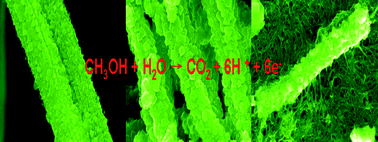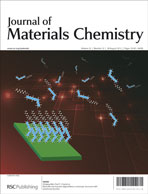Rational design of galvanically replaced Pt-anchored electrospun WO3 nanofibers as efficient electrode materials for methanol oxidation†
Abstract
Platinum/tungsten oxide (Pt/WO3) is a very important hybrid material system, which has been found to have wide applications from photochemistry to heterogeneous catalysis. For the first time, we combine electrospinning and galvanic replacement reaction as a new fabrication method for the in-situ anchoring of galvanically replaced Pt nanocubes and nanospheres onto the surface of electrospun WO3 nanofibers to yield a 1D heterostructure. This constructed nanostructure tied with carbon nanotubes as a novel nanostructured three-phase electrode for methanol oxidation exhibits exceptional catalytic activity. It is found that the morphology of both the Pt nanostructures and tungsten oxide support play an important role in the catalytic activity and stability for methanol oxidation. The peak current density of Pt nanocubes-anchored to WO3 nanofibers is about 4.5 times higher than that of their spherical counterparts under the same condition. The current decay with time for the Pt nanocubes/WO3 nanofibers is much slower than that for Pt nanocubes/commercial WO3. The novel multidimensional, multicomponent and multifunctional Pt/WO3 nanostructures offer a new material platform for solar cells, photocatalysis, fuel cells, sensors, and other applications. Such a hybrid design has been demonstrated to be an effective means for bridging functional nanoscale entities with a practical macroscale device.


 Please wait while we load your content...
Please wait while we load your content...